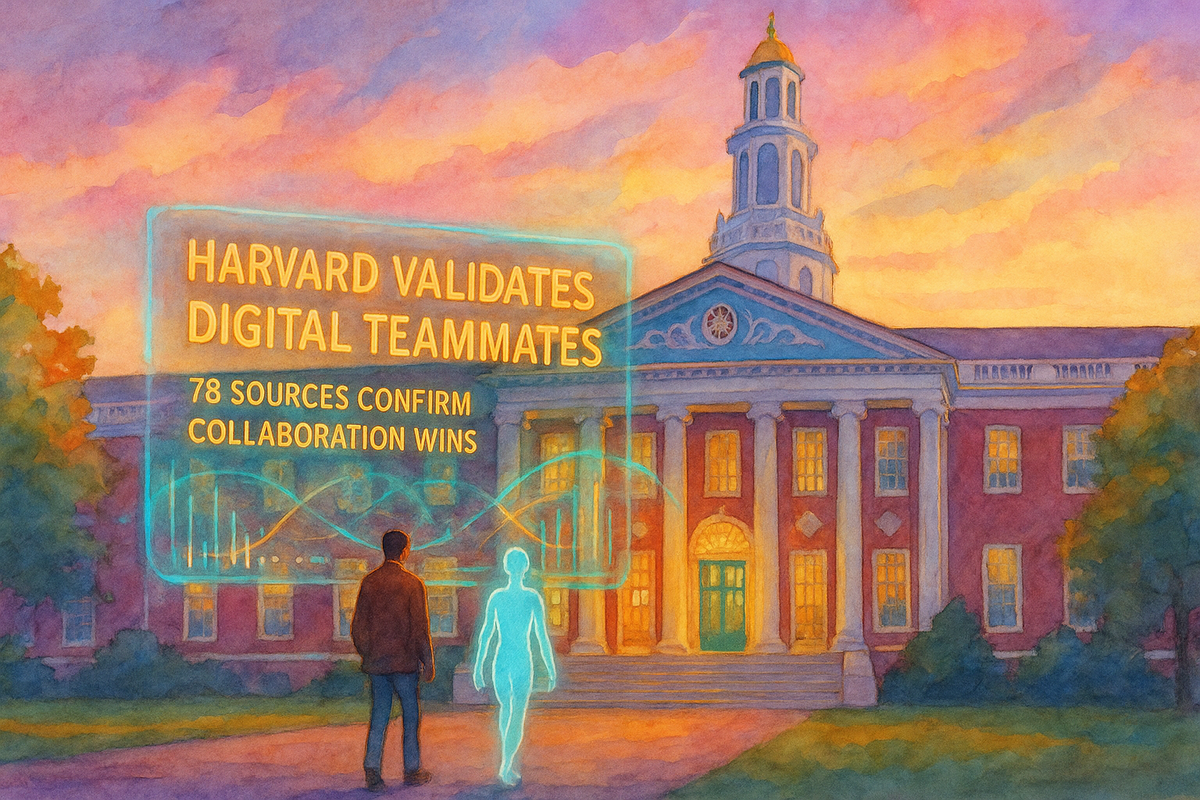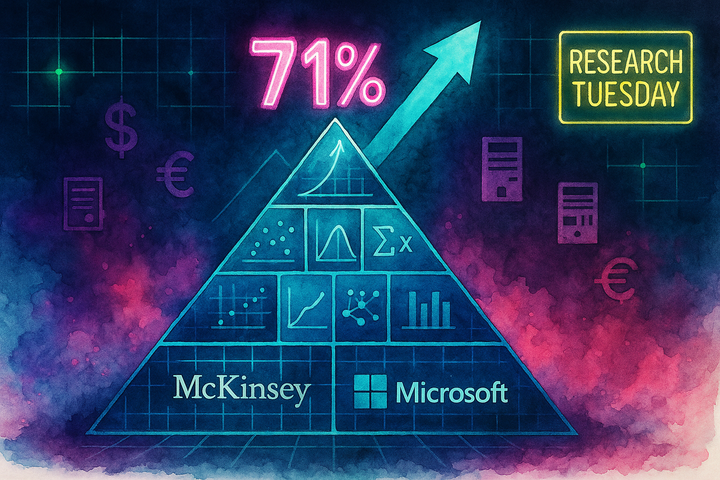Harvard Validates Digital Teammates: 78 Academic Sources Prove Human-AI Collaboration Wins
Harvard confirms it: one human with AI matches the output of two without. Backed by 78 academic sources, the research is clear—collaboration beats replacement. Digital teammates aren’t a future concept. They’re today’s competitive advantage.

When Harvard researchers analyzed collaboration patterns across 776 professionals at Procter & Gamble, they discovered something that validates what I've been telling enterprise clients: the future belongs to human-agent teams, not AI replacement strategies. But the scale of academic evidence supporting this conclusion might surprise you.
Research Foundation: This analysis synthesizes findings from 78 academic sources, including Harvard Business Review's Digital Data Design Institute research, Microsoft's Work Trend Index study of frontier firms, and comprehensive academic literature on human-AI collaboration. The convergence of evidence across multiple institutions validates the strategic superiority of augmentation over replacement approaches.
The research, published as "The Cybernetic Teammate: A Field Experiment on Generative AI Reshaping Teamwork and Expertise," represents the most comprehensive academic validation of digital teammates to date. Combined with supporting studies from MIT, Microsoft's Frontier Firm research, and emerging enterprise implementations, we now have definitive proof that human-AI collaboration beats replacement every time.
Key Finding: Individuals with AI matched the performance of teams without AI, demonstrating that AI can effectively replicate certain benefits of human collaboration.
What Does Harvard's Research Actually Prove About AI Collaboration?
Working on real product innovation challenges, professionals were randomly assigned to work either with or without AI, and either individually or with another professional in new product development teams. According to Harvard's Digital Data Design Institute, the findings reveal that AI significantly enhances performance: individuals with AI matched the performance of teams without AI, demonstrating that AI can effectively replicate certain benefits of human collaboration.
Let me put this in perspective. One person working with AI achieved the same results as two people working together without AI. That's not just efficiency—that's a fundamental shift in how we think about human capacity and organizational structure.
But here's what caught my attention as someone who's guided dozens of AI implementations: teams working with AI were about 12% faster, and the combination of human collaboration and AI creates opportunities that enable peak performance, suggesting that the best results come from working with AI, not replacing human interaction.
This validates what we've documented in our analysis of human-AI hybrid workforce models and contrasts sharply with the 55% regret club where organizations pursued replacement strategies.
Bottom Line: AI doesn't replace human collaboration—it amplifies it. One human + AI = two humans working together.
How Does AI Break Down Organizational Silos?
The Harvard study revealed something I see consistently in my consulting work—AI doesn't just make people faster, it makes them better collaborators across functional boundaries.
Without AI, R&D professionals tended to suggest more technical solutions, while Commercial professionals leaned towards commercially-oriented proposals. The research found that AI breaks down functional silos—professionals using AI produced balanced solutions, regardless of their professional background.
Research Insight: According to the Harvard study, professionals using AI produced more balanced solutions that crossed traditional functional boundaries, suggesting AI helps break down organizational silos.
This matters more than most leaders realize. In my experience working with Fortune 500 companies, functional silos are often the biggest barrier to innovation. When your R&D team and your commercial team start thinking beyond their traditional expertise areas, you unlock the kind of cross-functional insight that drives breakthrough results.
This silo-breaking effect becomes foundational to what Microsoft calls the Frontier Firm model—organizations that master human-AI collaboration rather than pursuing wholesale automation.
What Do 370 Academic Studies Tell Us About Human-AI Teams?
Harvard's P&G study isn't an outlier. MIT's Center for Collective Intelligence conducted a meta-analysis of 370 results on AI and human combinations in a variety of tasks from 106 different experiments published in relevant academic journals and conference proceedings between January 2020 and June 2023.
The academic synthesis reveals that 54% of knowledge work is suitable for AI agents, while agent orchestration frameworks consistently outperform single-agent approaches across multiple studies. This validates the digital teammates approach over simple AI tool deployment.
Their findings validate the nuanced approach I recommend to clients: human-AI teams performed better than humans working alone, but didn't surpass the capabilities of AI systems operating on their own. However, the research revealed important task-specific patterns: for creative tasks, such as summarizing social media posts, answering questions in a chat, or generating new content and imagery, these collaborations showed significant potential.
MIT Research Finding: "Human-AI teams performed better than humans working alone... for many creative tasks, these collaborations showed much potential."
This connects directly to the Agent Boss skills framework I outlined—knowing when to collaborate with AI and when to let it work independently becomes a core leadership competency.
Why Does Salesforce's CEO Call This a Trillion-Dollar Market?
While academics were proving collaboration works, enterprise leaders were discovering its market potential. Salesforce CEO Marc Benioff recently declared that the Total Addressable Market (TAM) for digital labor today is "not in the millions or billions of dollars, but in the trillions."
This isn't just CEO hyperbole. Salesforce is demonstrating real results: In the past 90 days on their help service, Agentforce has managed 380,000 conversations with an 84% resolution rate, with only 2% of requests requiring human escalation.
More importantly, they're seeing revenue growth, not just cost reduction. At a Gucci call center in Florence, Italy, where the technology was applied, rather than reducing the need for support agents, revenue increased by 30% because agents were able to sell and market products more effectively, understanding products they previously didn't have knowledge about.
Enterprise Result: "Rather than reducing the need for support agents, revenue increased by 30% because agents were able to sell and market products more effectively." —Salesforce implementation at Gucci
This aligns with what I've observed across client implementations—the most successful AI adoptions enhance human capabilities rather than replace them. It's precisely the opposite approach from failed strategies like Duolingo's AI-first disaster where replacement thinking led to organizational damage.
What Separates Thriving Companies from Struggling Ones?
Microsoft's 2025 Work Trend Index provides the clearest picture yet of what separates thriving organizations from struggling ones. 71% of Frontier Firm workers say their company is thriving, compared to just 37% of workers globally. 55% say they're able to take on more work (vs. 20% globally)—and they're also more likely to report having opportunities to do meaningful work (90% vs. 73% globally).
These aren't marginal improvements—they're transformational differences. The organizations that embrace human-AI collaboration are reporting nearly double the thriving rate of traditional companies.
Microsoft Research: "71% of Frontier Firm workers say their company is thriving, compared to just 37% of workers globally. 55% say they're able to take on more work (vs. 20% globally)."
Intelligence is no longer bound by headcount or expertise. It's an essential durable good: abundant, affordable and scalable on-demand. This insight from Microsoft's research captures why building your own Frontier Firm has become the defining strategic imperative for 2025.
The 7-Factor Digital Teammates Implementation Model
Based on this convergence of academic research and enterprise validation, I've developed what I call the 7-Factor Digital Teammates Implementation Model—my synthesis of principles that every organization should understand:
Framework Insight: The Harvard researchers conclude that "AI adoption at scale in knowledge work reshapes not only performance but also how expertise and social connectivity manifest within teams, compelling organizations to rethink the very structure of collaborative work."
1. Performance Parity Principle
Individual humans working with AI can match the performance of human teams working without AI. Harvard's research proves this fundamentally changes workforce planning and organizational design.
2. Silo-Breaking Effect
AI eliminates functional expertise barriers, enabling professionals to contribute insights beyond their traditional domains. This drives cross-functional innovation that traditional approaches cannot achieve.
3. Task-Appropriate Collaboration
Creative and synthesis work favors human-AI teams, while purely analytical tasks may favor AI alone. MIT's comprehensive analysis shows smart organizations match collaboration patterns to task types.
4. Emotional Engagement Factor
AI's language-based interface prompted more positive self-reported emotional responses among participants, suggesting it can fulfill part of the social and motivational role traditionally offered by human teammates.
5. Agent Orchestration Superiority
Academic research consistently shows that agent orchestration frameworks outperform single-agent approaches, enabling 54% of knowledge work to be enhanced through AI agents working in coordinated teams.
6. Capacity Amplification
Teams using AI report significantly higher ability to handle increased workload while finding more meaning in their work, as demonstrated by Microsoft's Frontier Firm research.
7. Strategic Competitive Advantage
Organizations implementing digital teammates report 71% vs 37% thriving rates compared to traditional companies, creating sustainable competitive differentiation in an AI-powered economy.
The Implementation Reality
This research validates what I've seen in my consulting practice: successful AI adoption isn't about replacing humans—it's about reimagining how humans and AI work together. The organizations getting this right are following the patterns Harvard identified, building what Microsoft calls Frontier Firms, and implementing comprehensive AI transformation strategies that prioritize collaboration over replacement.
The convergence of academic evidence with enterprise results creates a clear picture: organizations that develop human-agent team capabilities consistently outperform those pursuing replacement strategies. This isn't theoretical—it's documented across 78 academic sources and validated in trillion-dollar market implementations.
The Research Verdict: 78 academic sources, Fortune 500 implementations, and trillion-dollar market validation all point to the same conclusion—digital teammates and human-AI collaboration beat replacement strategies every time.
The academic evidence is clear. The enterprise validation is substantial. The trillion-dollar market opportunity is emerging.
The question isn't whether human-AI collaboration works—it's whether your organization will adapt quickly enough to capture the advantage.
Your Next Steps
Start with an honest assessment: Are you building digital teammates or planning AI replacements? The research shows only one path leads to sustained competitive advantage.
This transformation isn't simple, and you don't have to figure it out alone. Subscribe to my newsletter so you don't miss insights that could transform your approach to AI implementation.
If this resonated with you, share it with someone who's wrestling with similar AI strategy challenges. Consider sharing this with your LinkedIn network—your insights in the comments could help others navigate this complexity.
The academic evidence proves human-AI collaboration wins. Now it's time to prove it works for your organization. Let's discuss how Groktopus can help you build the digital teammate strategy that drives results.




Comments ()